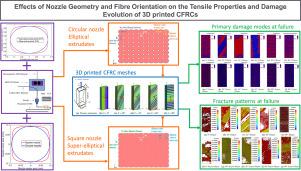喷嘴几何形状和纤维取向对 3D 打印连续纤维增强复合材料拉伸强度的影响
IF 10.3
1区 工程技术
Q1 ENGINEERING, MANUFACTURING
引用次数: 0
摘要
在基于材料挤压(MEX)的三维打印中,丝间空隙是打印过程中固有的现象。空隙的方向、体积和形状受多种因素影响,包括喷嘴形状、堆叠顺序和打印方向。本研究通过数值方法研究了纤丝间空隙对三维打印丙烯腈-丁二烯-苯乙烯-碳纤维(ABS/CF)连续纤维增强复合材料(CFRC)的拉伸性能和损伤模式的不利影响。在进行单轴拉伸模拟时,考虑了各种喷嘴几何形状(圆形、方形)、纤维相对于加载方向的取向(θ=0o,30o,45o,60o,90o)以及挤出物的规则堆叠顺序。挤出物横截面分别采用椭圆形或超椭圆形挤出物建模,挤出物从圆形或方形喷嘴中挤出。模拟结果与几项已发表的实验和数值研究结果进行了比对,结果表明两者非常吻合。模拟结果表明,将喷嘴形状从圆形改为方形后,所有纤维角度的机械性能都得到了改善,空隙率降低了 7-8%,极限拉伸强度(σT)提高了 11-18%,拉伸刚度(ET)提高了 6-8%,拉伸破坏应变(ϵT,fail)提高了 1-11%。对于超椭圆挤出物,观察到的损坏模式数量也有所减少,这是因为纤维间和层间结合长度分别提高了 37.2% 和 58.2%。此外,当纤维角度越来越偏离拉伸载荷方向时,圆形和方形喷嘴的强度、模量和破坏应变都会降低。通过将这些结果与分析计算结果和无空隙均质实心 CFRC 块的模拟结果进行比较,突出了使用微结构几何形状和明确模拟纤维间空隙对模拟 MEX 印刷 CFRC 的重要性。本文章由计算机程序翻译,如有差异,请以英文原文为准。

Effects of nozzle geometry and fiber orientation on the tensile strength of 3D printed continuous fiber reinforced composites
In material extrusion (MEX) based 3D printing, inter-filament voids are intrinsic to printing process. The void orientation, volume and shape are affected by multiple factors including the nozzle shape, stacking sequence and printing direction. In this study, the adverse effects of the inter-filament voids on tensile properties and damage modes were investigated numerically on 3D printed acrylonitrile butadiene styrene-carbon fiber (ABS/CF) continuous fiber-reinforced composites (CFRCs). Uniaxial tensile simulations were performed considering various nozzle geometries (circular, square), fiber orientations () relative to loading direction, and a regular stacking sequence of extrudates. The extrudate cross-section was modeled either using elliptical or superelliptical extrudates deposited from a circular or square nozzle, respectively. Excellent agreement was seen when the simulated results were benchmarked against several published experimental and numerical work. Simulated results showed that changing the nozzle shape from circular to square improved the mechanical properties across all fiber angles by lowering the void content by and increasing the ultimate tensile strength () by , tensile stiffness () by , and the tensile failure strains () by . For superelliptical extrudates the number of observed damage modes also reduced, and this is due to a 37.2% and 58.2% improvement in the inter-filament and inter-layer bond lengths, respectively. Also, when fiber angle became increasingly off-axis to tensile load direction, the strengths, moduli, and failure strains reduced for both circular and square nozzles. The significance of using microstructure geometries and explicitly modeling inter-filament voids for simulating MEX printed CFRCs was highlighted by comparing these results with both analytical calculations and simulated results of homogeneous solid CFRC blocks without voids.
求助全文
通过发布文献求助,成功后即可免费获取论文全文。
去求助
来源期刊

Additive manufacturing
Materials Science-General Materials Science
CiteScore
19.80
自引率
12.70%
发文量
648
审稿时长
35 days
期刊介绍:
Additive Manufacturing stands as a peer-reviewed journal dedicated to delivering high-quality research papers and reviews in the field of additive manufacturing, serving both academia and industry leaders. The journal's objective is to recognize the innovative essence of additive manufacturing and its diverse applications, providing a comprehensive overview of current developments and future prospects.
The transformative potential of additive manufacturing technologies in product design and manufacturing is poised to disrupt traditional approaches. In response to this paradigm shift, a distinctive and comprehensive publication outlet was essential. Additive Manufacturing fulfills this need, offering a platform for engineers, materials scientists, and practitioners across academia and various industries to document and share innovations in these evolving technologies.
 求助内容:
求助内容: 应助结果提醒方式:
应助结果提醒方式:


